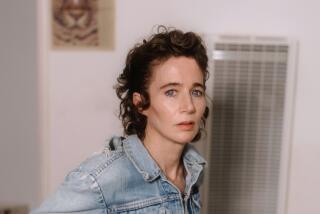A Look at the Women Who Influenced a Century
- Share via
On a cold March day in 1941, Virginia Woolf filled her pockets with stones, walked into the Ouse River near her home in Sussex, England, and drowned. Woolf, an author and feminist whose time had yet to come, was depressed about many things, not the least of which was the pervasive discrimination against women.
But, according to a new book published by Ladies’ Home Journal, there was already hope on the horizon. Along with World War II, notes the book, the other big event of 1941 was the magazine’s launch of its famous slogan, “Never Underestimate the Power of a Woman.”
As the publisher of women’s features and news since 1883, the Journal certainly has the credentials to document how women have wielded their estimable powers in every area of human endeavor. And, despite the obvious high regard the magazine holds for itself, who better to offer the first pre-millennium list of “100 Most Important Women of the 20th Century.”
From Rosa Parks and Martha Stewart to Madame Curie and Marilyn Monroe, the Journal uses photographs and thumbnail biographies to bring to life women whose contributions in the arts, and in science, politics, business, literature and sports continue to influence women today.
Because many already have been featured in the pages of the magazine, the field is a decidedly popularized one. That is to say, you’ll find more celebrities than Nobel Prize winners. (Then again, not many women have been given Nobel Prizes.)
From the feminist / antifeminist debate, the book offers Phyllis Schlafly who, despite her insistence that women belong at home, forever will be remembered not as the mother of six children, but as the woman who brought down the Equal Rights Amendment.
On the page facing Schlafly’s entry is her charismatic foe, Gloria Steinem. As founding editor of Ms., the world’s first mainstream feminist magazine, Steinem was, for a time, the “drop-dead gorgeous” face of the feminist movement.
From the chapter on entrepreneurs come mini-bios of diet diva Jean Nidetch, who founded Weight Watchers, and Ruth Handler, who patented the Barbie doll, as well as Elsie de Wolfe, the country’s first professional interior decorator.
A few of the book’s omissions are surprising. Ann Landers (a.k.a. Eppie Lederer) is in the book, naked in a bubble bath while holding a phone and reading letters. But her identical twin, Abigail Van Buren, who with her Dear Abby column does essentially the same work, is nowhere to be found. Amelia Earhart is in; first female astronaut Sally Ride is out. Virginia Apgar, the physician who came up with the life-saving Apgar Score for newborns is in, but Marion Donovan, the “housewife” who invented the disposable diaper, is out.
When the first issue of Ladies’ Home Journal appeared at the end of the 19th century, women were called ladies and home was still pretty much where you’d find them. The few who left home to go to work typically earned 30 cents a day working 70-hour weeks in factory sweatshops.
“[Women] were decorative, disenfranchised and defined almost entirely by [their] relationships with men,” writes Barbara Walters, who as a pioneer for women’s rights in the broadcasting world, made it into the book as the first anchorwoman and wrote its introduction.
Exploring a century of women’s work in less than 200 pages is a daunting challenge, and the editors at Ladies’ Home Journal clearly tried hard.
But as “Babe” Didrikson Zaharias, the Journal’s pick for best female athlete of the century, put it: “It’s not enough just to swing at the ball. You’ve got to loosen your girdle and really let her fly.”
For more reviews, see Sunday Book Review
This week:
The best nonfiction of 1998, including biography, history and memoir.
More to Read
Sign up for our Book Club newsletter
Get the latest news, events and more from the Los Angeles Times Book Club, and help us get L.A. reading and talking.
You may occasionally receive promotional content from the Los Angeles Times.










